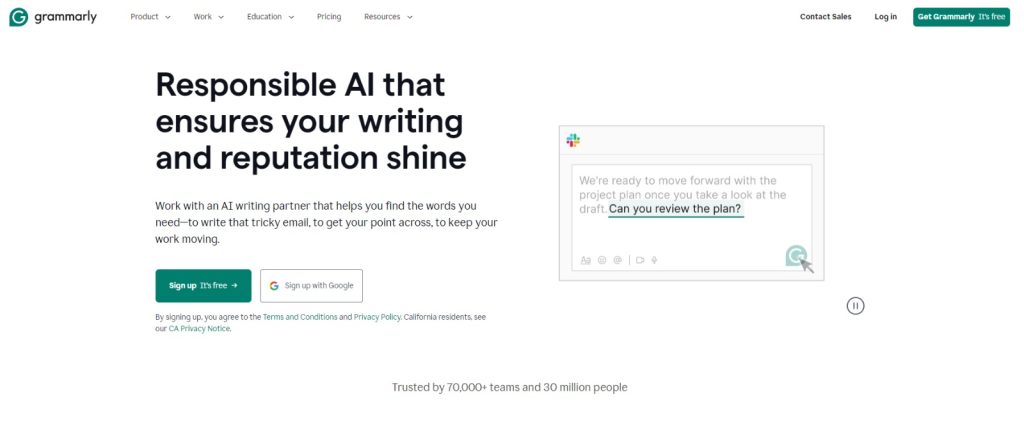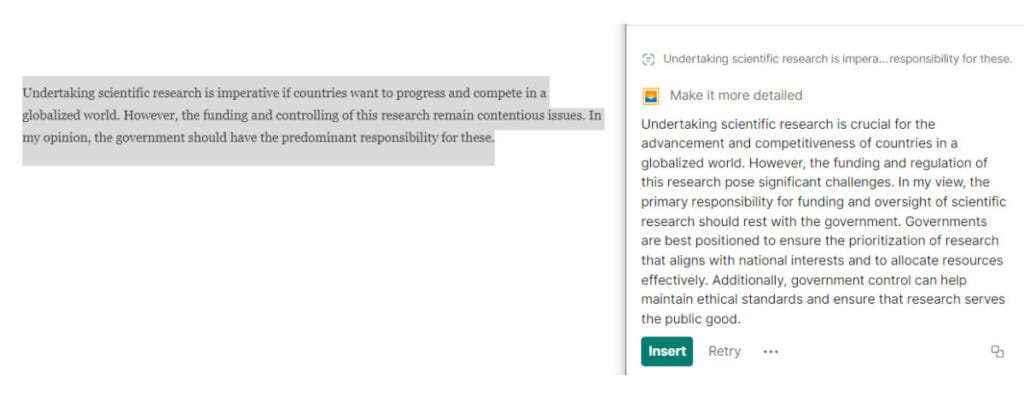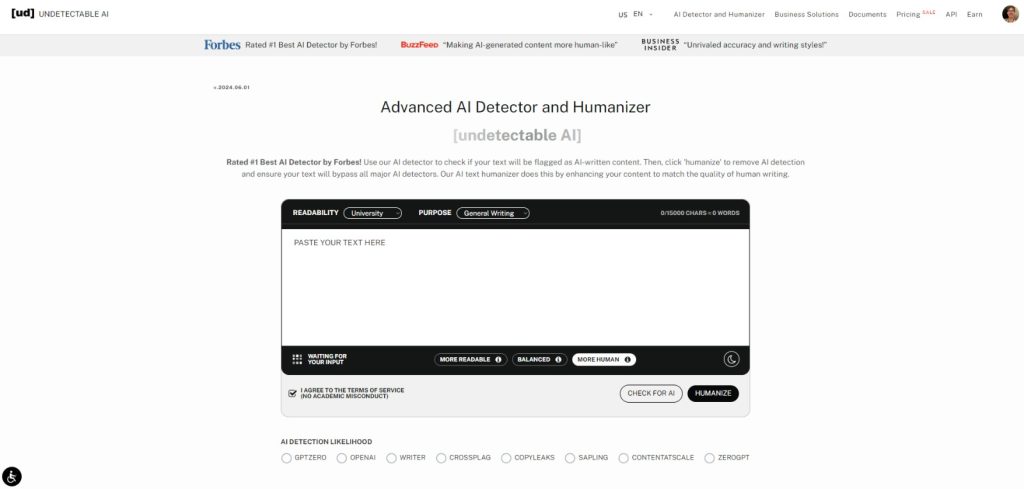For many years, Grammarly has been one of the go-to third-party spell-checkers for students, writers, and other professionals.
Through its browser extensions and desktop and mobile apps, users can fix their grammar and style issues with a few clicks.
This year, the company made a massive leap.
With the popularity of AI in different applications, Grammarly created its own.
Let’s take a closer look at how Grammarly leverages this tech and answer the question, “Does Grammarly count as AI?”
Can Grammarly be Detected as AI?
It’s a yes and no answer.
Since 2009, the platform has employed a combination of rule-based systems and natural language processing (NLP) techniques.
These foundational elements allow it to analyze written text and offer suggestions.


Never Worry About AI Detecting Your Texts Again. Undetectable AI Can Help You:
- Make your AI assisted writing appear human-like.
- Bypass all major AI detection tools with just one click.
- Use AI safely and confidently in school and work.
It works based on pre-defined grammatical rules and contextual analysis.
Initially, much of its capability came from extensive linguistic databases.
Later, it added algorithms to parse sentences, detect anomalies, and offer corrections.
With the advent of more sophisticated models, Grammarly began integrating these to enhance its offerings.
Specifically, it started utilizing deep learning networks to better understand context and semantics. Providing more nuanced and accurate suggestions.
So, for a good chunk of its functionality, the general answer is no, Grammarly isn’t AI. It only provides grammar and spelling corrections.
It didn’t have the capability to perform tasks such as generating original content or responding to prompts.
Until last year.
Does Grammarly Use AI?

As we discussed earlier, Grammarly’s foundation involves a blend of human insights, rule-based systems, and NLP algorithms. It creates a framework that “enhances” user-generated content.
However, its recent integration of AI has evolved significantly.
Last year, it introduced its “AI Writing Assistant,” marking a substantial leap in its capabilities.
Remember that the app’s base models helped discern intricate language patterns.
These enhancements, however, were primarily reactive. They gave users more insightful grammar, punctuation, and style suggestions.
Although they improved upon user input text, they did not generate new content autonomously.
Grammarly took a pioneering step by launching its AI Writing Assistant.
This new feature fundamentally changed the dynamics of text creation on the platform.
Now, it’s more closely aligned with generative AI models like ChatGPT and Gemini.
Here’s a detailed breakdown of the AI Writing Assistant:
1. Generative Capabilities
Unlike traditional Grammarly tools that merely suggest corrections and improvements, the AI Writing Assistant can generate text based on user prompts.
It uses sophisticated models trained on extensive datasets. Capturing a wide range of writing styles, tones, and context-specific nuances.
2. User Input and Initialization
While the Writing Assistant offers generative functionalities, it doesn’t entirely remove the need for user input.
Users must provide an initial prompt or a brief outline of the content they wish to create.
You also need to write something initially, and the feature will act as a paraphraser—but it will be more detailed and advanced.
3. Context-Aware Generation
If a user initiates a prompt within a formal business report, the generated content will reflect an appropriately formal tone. It reads what you write and can mimic the tone of your content.
4. Underlying Technology
It utilizes transformer-based models similar to those used by ChatGPT. It relies on attention mechanisms to understand and generate human-like text.
It does this by predicting the next word in a sequence, given a prior context.
One thing to note is the ethical considerations and user control of this feature.
Many content writers are aware of Google’s policy. Although the search engine giant clearly said they aren’t against the use of AI, many are still cautious.
Grammarly places a significant emphasis on ethical use.
Users retain full control over the generated content, with the ability to review, modify, or discard AI suggestions.
Making sure that the writer remains at the helm, using AI as a tool to enhance creativity and productivity rather than replace it.
Grammar Checker vs. AI Writing
We’ve discussed the technical details of Grammarly’s grammar checker and its new AI writing assistant, but let’s dive a little deeper into how they work.
The grammar checker suggests spelling, phrasing, grammar, punctuation, sentences, capitalization, and other small features that improve writing.
It uses a rule-based system and Whitelists/Blacklists for suggestions. If a word wasn’t in the possible inputs white list—it raises an error message with suggested options.
On the other hand, the writing assistant will create content based on a prompt.
Say you want a paragraph or a sentence to sound more aggressive, then it’ll paraphrase it for you. Sound basic? Think again.
When you ask Grammarly to convert a text into more detailed content, it’ll add more information to your text. Let’s give it a try.
These excerpts are from an IELTS Scientific Research Essay. A paragraph was copied and followed Grammarly’s suggestion:

As you can see from the snippet above, the original text requires a bit of editing. Grammarly suggested rephrasing it for correctness and tone. Here’s the edited output:

The changes were very subtle, and they didn’t change the substance of the paragraph. Now let’s try using it’s writing assistant.
The same original text was put through one of Grammarly’s pre-created prompts (“Make it more detailed”).

It didn’t change the context of the paragraph, but it added more details to support the argument.
It explained further why governments are best positioned to fund and oversee research.
So, how does this affect AI content detection? Will it be flagged? Subtle edits using Grammarly have a low risk of being flagged as AI-generated.
But when used to generate additional content, it will potentially marked as AI.
So, how do you prevent this? How can you enjoy Grammarly’s full features without getting flagged?
Tips and Strategies for Using AI Tools Without Getting Flagged
So, you’ve used ChatGPT or Grammarly to help you write a piece of content.
How do you de-roboticize it? How do you get the initial AI draft done and then quickly add your own human elements to rank on search engines?
Google completely removed some spammy AI sites with their March 2024 core update.
How can you create high-quality content faster using AI tools that also pass AI content detection?
Customize and Personalize AI Content
You want to add examples, whether it’s informational how-to content or transactional best-of-product content.
Say you’re writing a Pre Workout Product review. Try adding some real-life stories about your experience.
State what you like and dislike using human words. “I liked this, but I did not like this,” or “A lot of people do it this way, but I recommend doing it this way.”
The more you use these “I” phrases—first-person experiences—the better. Pros and cons lists, tables, charts, and graphs all help express your unique take.
Employ Undetectable AI Humanizer Tool

Undetectable AI is a tool that allows you to humanize your content so that it’s less likely to be detected as AI-written.
Copy and paste that content into the website and choose whether to detect or humanize your content.
If you copied unedited ChatGPT content, it’s very likely to be detected by AI.
Once you’ve created an account, you’ll see a simple interface. Scroll a little bit down the page and you’ll find a quick tutorial on getting started.
Depending on the type of content you’ll be scanning, you can customize it to high school, university, doctorate, journalist, or even marketing.
You can then tell it the purpose, whether it’s an essay, general writing, a story, a cover, etc.
At the bottom, you have some further personalized options.
You can tell the tool to be more readable, more balanced between AI and human, or just more human.
You can then copy the output, or if you’re not happy with its rewrite, click humanize again to redo it.
You can also compare it with your original submission at the bottom.
Review and Proofread Thoroughly
Proofreading is the last step to enhance the readability of your content.
Check grammar using Grammarly, but after reviewing and editing, perform another read-through and check everything.
Misspellings and illogical or uneven use of punctuation will make your sentences senseless.
Em-dashes, semicolons, colons, and exclamation points should be used carefully and only when absolutely necessary.
For readability, watch your sentence length. If you are writing copy for the web, aim to have sentences of 20 words or less.
This includes filler words like “a,” “and,” “the,” and anything in between.
That is not to say that every sentence has to be short, just that the majority should be clear, concise, and to the point.
Grammarly can also help you highlight all the times you use passive voice, and then you can consciously change it to active.
In web writing, aim to use the active voice as much as possible so it won’t sound robotic or AI-generated.
FAQ’s
Is Using Grammarly AI Cheating?
No. It provides you with suggestions for grammar, punctuation, style, and clarity issues. It’s basically a more advanced spell-checker.
Is Grammarly Allowed in College?
Generally, yes. However, it heavily relies on the institution or guidelines your professors implement.
Is Grammarly Considered AI?
Yes, now. Since its inception, Grammarly has used NLPs and rule-based systems to analyze text and provide suggestions for real-time writing. Its new feature, the “AI Writing Assistant,” uses generative AI models to create content using prompts.
Conclusion
Grammarly has evolved from a traditional grammar checker into a robust AI-powered writing assistant.
Its integration of advanced AI technologies allows for nuanced content generation and enhanced user support.
If you’re concerned about AI content detection, tools like Undetectable AI can help.
By humanizing AI-generated text, Undetectable reduces the risk of being flagged as machine-written.
This tool adjusts content to appear more natural and authentic, offering customizable options to suit different writing needs.
Together, Grammarly and Undetectable AI provide a powerful combination for effective, human-like writing in the digital age.
By integrating Undetectable into your workflow, you can confidently take advantage of AI tools to enhance productivity without having to compromise on authenticity.
Try the Undetectable AI widget today and stay ahead in a world where authenticity matters more than ever.
